用户和权限
¥Users & Permissions
Page summary:
Users & Permissions manages end-user accounts, JWT-based authentication, and role-based access to APIs. This documentation explains how to create roles, configure permissions, and issue API tokens for secure access control.
用户和��权限功能允许管理终端用户
¥The Users & Permissions feature allows the management of the end-users
Strapi 项目的。它提供基于 JSON Web Tokens (JWT) 的完整身份验证过程来保护你的 API,以及访问控制列表 (ACL) 策略,使你能够管理用户组之间的权限。
¥of a Strapi project. It provides a full authentication process based on JSON Web Tokens (JWT) to protect your API, and an access-control list (ACL) strategy that enables you to manage permissions between groups of users.
管理面板配置
¥Admin panel configuration
用户和权限功能可从管理面板设置和代码库进行配置。
¥The Users & Permissions feature is configured from both the admin panel settings, and via the code base.
角色
¥Roles
用户和权限功能允许为终端用户创建和管理角色,以配置他们可以访问的内容。
¥The Users & Permissions feature allows to create and manage roles for end users, to configure what they can have access to.
创建新角色
¥Creating a new role
路径: 用户和权限插件 > 角色
¥Path: Users & Permissions plugin > Roles
在角色界面的右上角,显示一个添加新角色按钮。它允许为 Strapi 应用的终端用户创建新角色。
¥On the top right side of the Roles interface, an Add new role button is displayed. It allows to create a new role for end users of your Strapi application.
单击添加新角色按钮以重定向到角色编辑界面,你可以在其中命名新角色并定义其详细信息和权限(参见 编辑角色)。
¥Click on the Add new role button to be redirected to the roles edition interface, where you will be able to name your new role and define its details and permissions (see Editing a role).
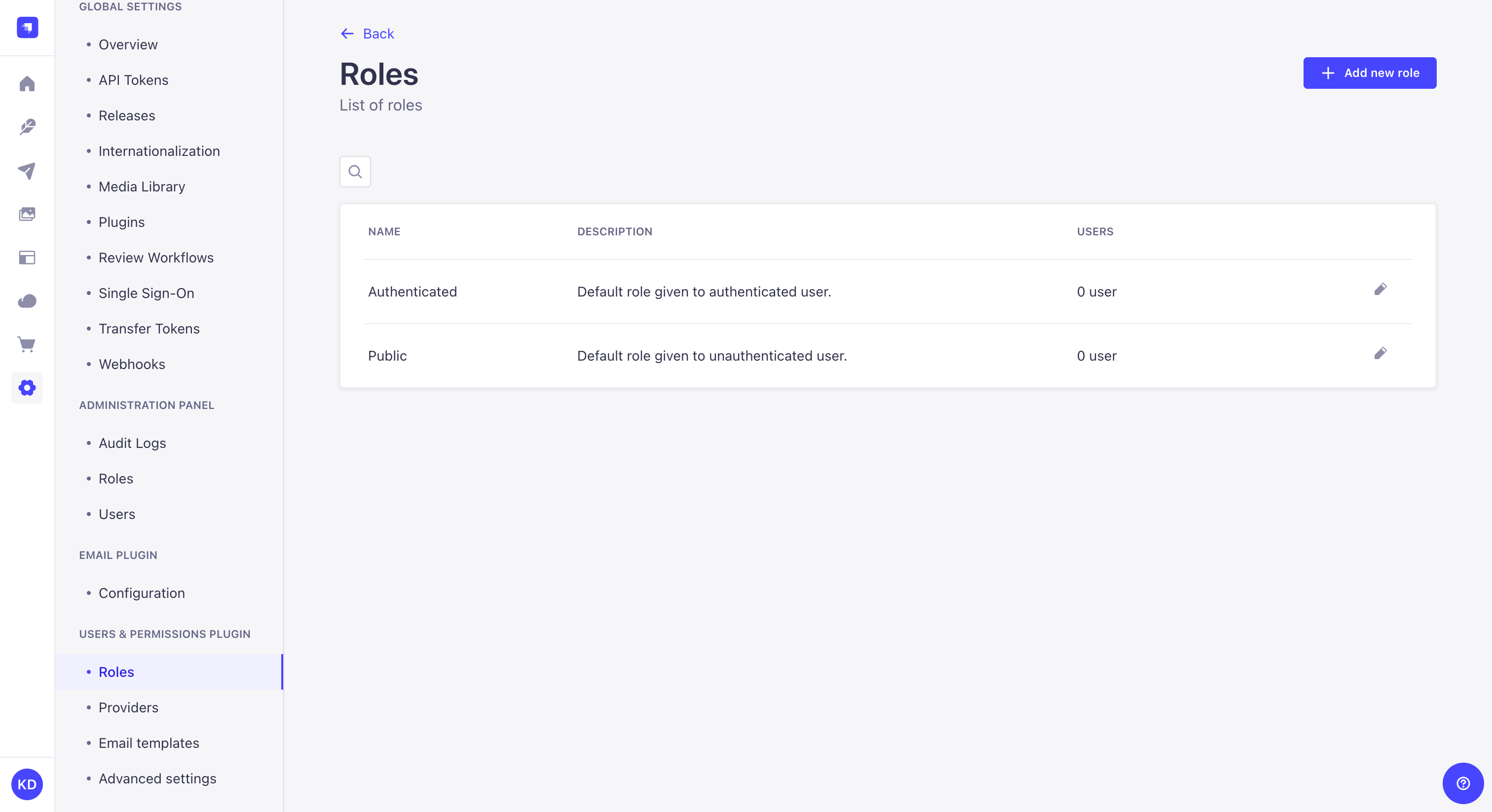
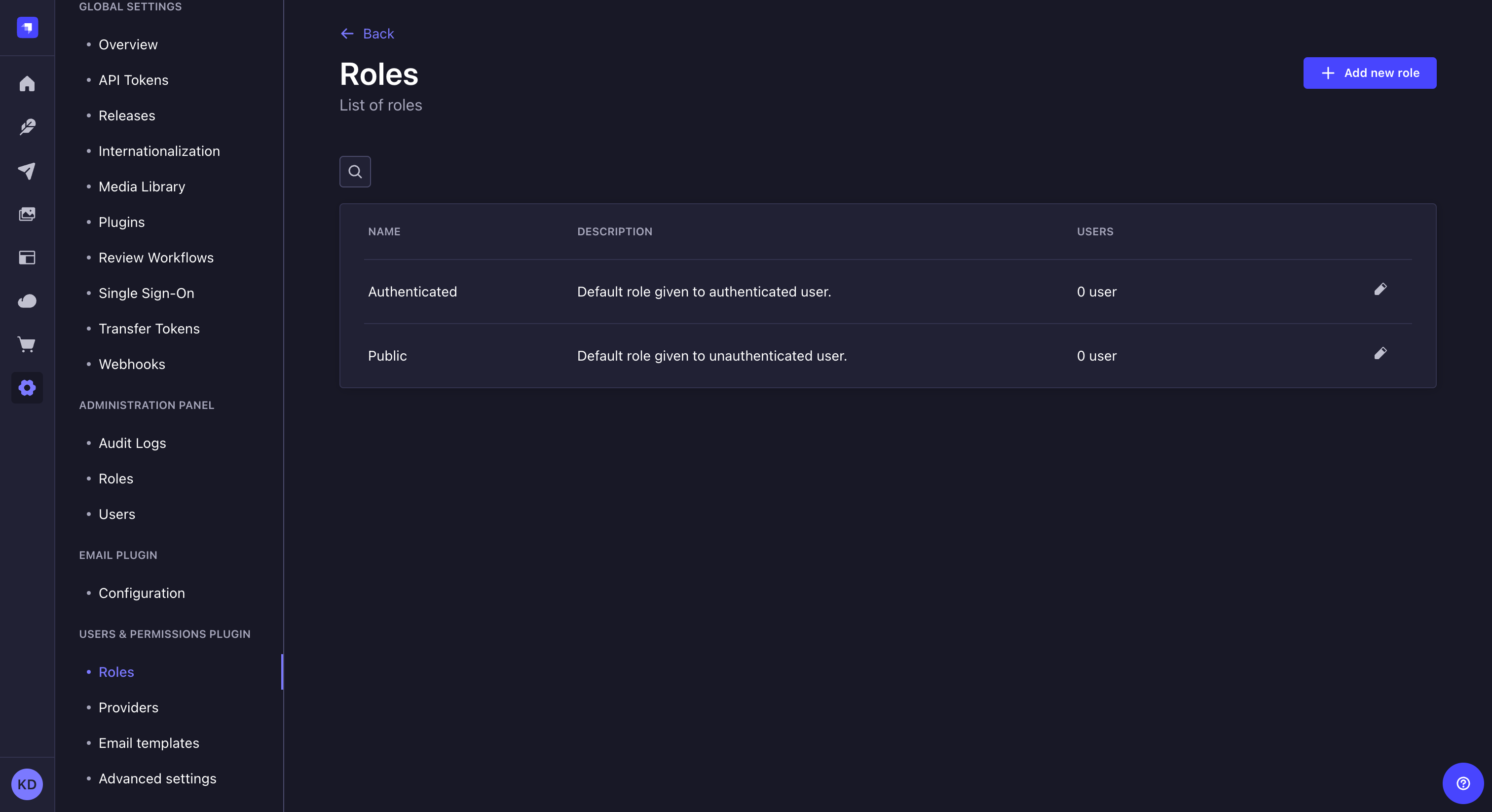
默认情况下归属于所有新终端用户的终端用户角色可以在用户和权限插件的高级设置子部分中定义(请参阅 高级设置)。
¥The end-user role attributed by default to all new end users can be defined in the Advanced settings sub-section of Users & Permissions plugin (see Advanced settings).
编辑角色
¥Editing a role
路径: 用户和权限插件 > 角色
¥Path: Users & Permissions plugin > Roles
角色界面显示为 Strapi 应用的终端用户创建的所有角色。
¥The Roles interface displays all created roles for the end users of your Strapi application.
默认情况下,为任何 Strapi 应用定义 2 个终端用户角色:
¥By default, 2 end-user roles are defined for any Strapi application:
-
已验证:仅当终端用户登录到前端应用时才能访问内容。
¥Authenticated: for end users to access content only if they are logged in to a front-end application.
-
民众:供终端用户无需登录前端应用即可访问内容。
¥Public: for end users to access content without being logged in to a front-end application.
但是可以创建更多角色(参见 创建新角色),并且所有角色都可以通过角色编辑界面进行编辑。
¥More roles can however be created (see Creating a new role), and all can be edited through the role edition interface.
-
单击要编辑的角色的编辑按钮 — 除非你直接从创建新角色进入角色编辑界面。
¥Click on the edit button of the role to edit — except if you directly landed on the role edition interface from creating a new role.
-
按照下表中的说明填写角色详细信息:
¥Fill in the Role details, following the instructions from the table below:
| 角色详情 | 指示 |
|---|---|
| 名称 | 在文本框中写入角色的新名称。 |
| 描述 | 在文本框中写下角色的描述。它应该帮助管理员了解角色授予访问权限的内容。 |
-
通过以下方式配置终端用户角色的权限:
¥Configure the end-user role's Permissions by:
-
单击要配置的权限类别的名称(例如应用、内容管理器、电子邮件等)。
¥Clicking on the name of the permission category to configure (e.g. Application, Content-Manager, Email etc.).
-
勾选要授予角色的操作和权限的框。
¥Ticking the boxes of the actions and permissions to grant for the role.
-
-
单击“保存”按钮。
¥Click on the Save button.
当勾选某个操作或权限框时,界面右侧会显示该 API 的相关绑定路由。
¥When ticking an action or permission box, related bound routes of the API are displayed in the right side of the interface.

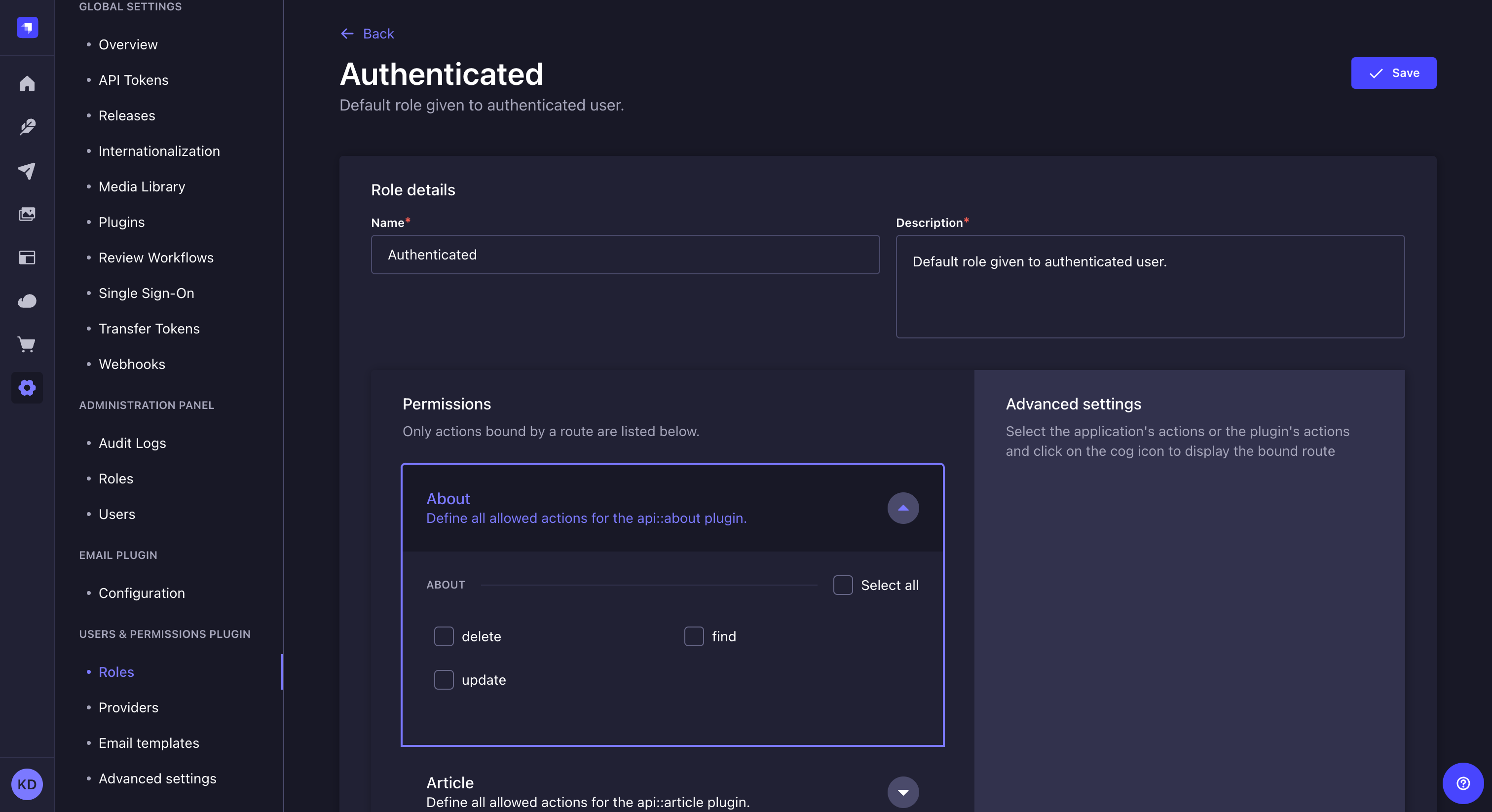
删除角色
¥Deleting a role
路径: 用户和权限插件 > 角色
¥Path: Users & Permissions plugin > Roles
尽管无法删除 2 个默认终端用户角色,但其他角色可以删除,只要没有终端用户仍将此角色归属于其账户即可。
¥Although the 2 default end-user roles cannot be deleted, the other ones can, as long as no end user still has this role attributed to their account.
-
点击角色记录右侧的删除按钮 。
¥Click on the delete button on the right side of the role's record.
-
在删除窗口中,单击 确认按钮以确认删除。
¥In the deletion window, click on the Confirm button to confirm the deletion.
提供者
¥Providers
路径: 用户和权限插件 > 提供商
¥Path: Users & Permissions plugin > Providers
用户和权限功能允许启用和配置提供商,以便终端用户通过第三方提供商登录,通过 Strapi 应用 API 访问前端应用的内容。
¥The Users & Permissions feature allows enabling and configuring providers, for end users to login via a third-party provider to access the content of a front-end application through the Strapi application API.
默认情况下,提供程序列表可用,其中包括一个 "电子邮件",默认情况下,所有启用了用户和权限的 Strapi 应用都启用了该列表。
¥By default, a list of providers is available including one, "Email", enabled by default for all Strapi applications with Users & Permissions enabled.
-
点击提供商的编辑 按钮进行启用和配置。
¥Click on the edit button of the provider to enable and configure.
-
在提供商版本窗口中,单击启用选项的 TRUE 按钮。
¥In the provider edition window, click on the TRUE button of the Enable option.
-
填写提供商的配置。每个提供商都有自己特定的配置集(参见 用户和权限提供商文档)。
¥Fill in the provider's configurations. Each provider has its own specific set of configurations (see Users & Permissions providers documentation).
-
单击“保存”按钮。
¥Click on the Save button.

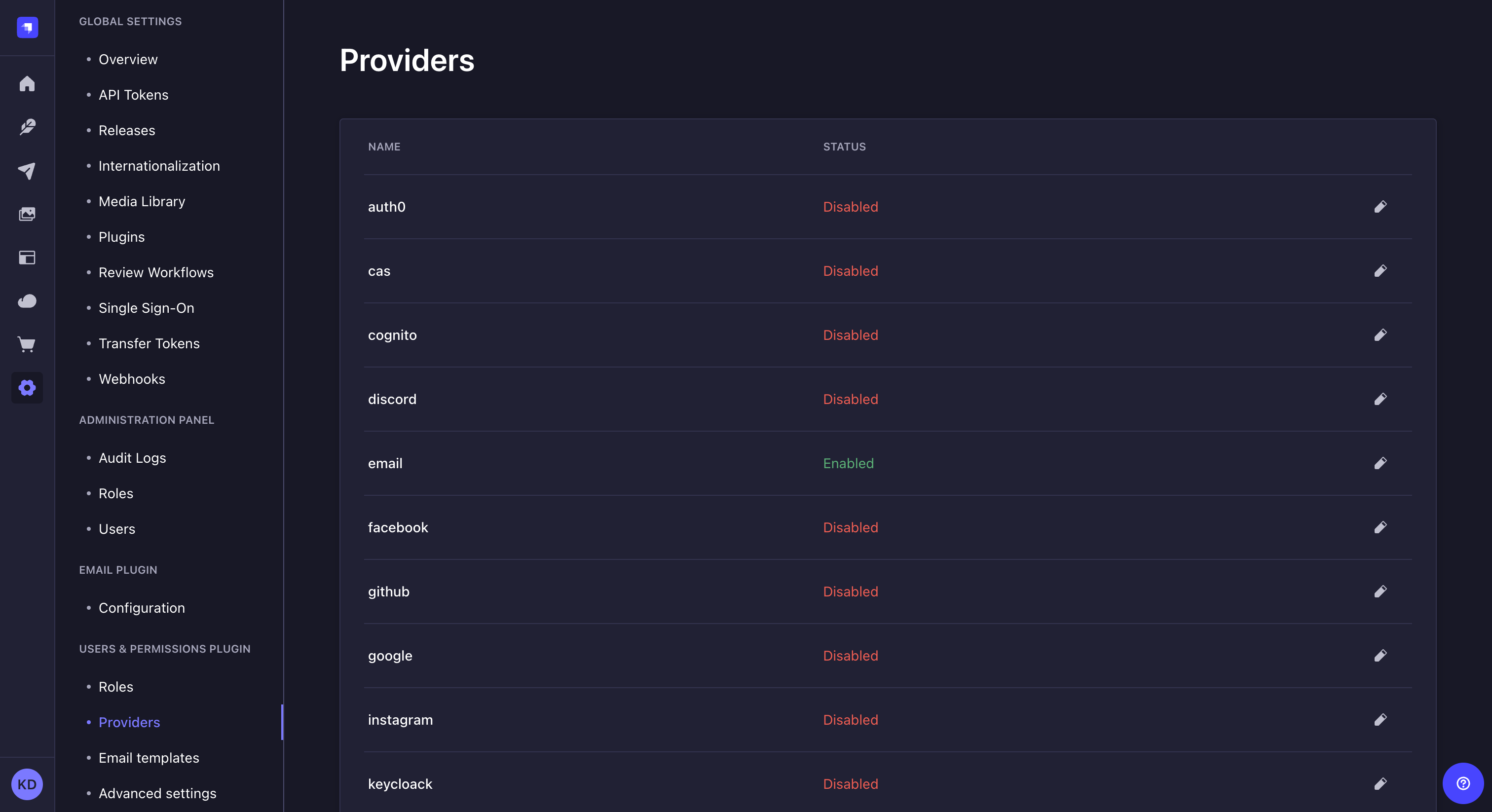
Strapi 默认未提供的其他提供程序可以通过 Strapi 应用的代码手动添加。点击以下任意卡片,获取有关配置或创建第三方提供商的更多信息:
¥Other providers that are not proposed by default by Strapi can be added manually through the code of your Strapi application. Click on any of the following cards to get additional information on configuring or creating third-party providers:
Setting up providers
Learn how Users & Permissions providers work, understand the login flow, and see common examples.
Creating a custom provider
Learn how to create your own custom provider for the Users & Permissions feature.
电子邮件模板
¥Email templates
路径: 用户和权限插件 > 电子邮件模板
¥Path: Users & Permissions plugin > Email templates
用户和权限功能使用 2 个电子邮件模板 "电子邮件地址确认" 和 "重设密码",发送给终端用户:
¥The Users & Permissions feature uses 2 email templates, "Email address confirmation" and "Reset password", that are sent to end users:
-
如果必须确认他们的账户才能激活,
¥if their account must be confirmed to be activated,
-
如果他们需要重置 Strapi 账户的密码。
¥if they need to reset the password of their Strapi account.
两个电子邮件模板都可以修改。
¥Both email templates can be modified.
-
点击电子邮件模板的编辑 按钮进行配置和编辑。
¥Click on the edit button of the email template to configure and edit.
-
配置电子邮件模板:
¥Configure the email template:
设置名称 指示 发货人名称 注明电子邮件发送者的名称。 发送者电子邮件 注明电子邮件发送者的电子邮件地址。 响应电子邮件 (可选)指示终端用户的响应电子邮件将发送到的电子邮件地址。 主题 写下电子邮件的主题。可以使用变量(参见 模板电子邮件)。 -
在 "信息" 文本框中编辑电子邮件的内容。电子邮件模板内容采用 HTML 格式并使用变量(请参阅 模板电子邮件)。
¥Edit the content of the email in the "Message" textbox. Email templates content is in HTML and uses variables (see templating emails).
-
单击完成按钮。
¥Click on the Finish button.
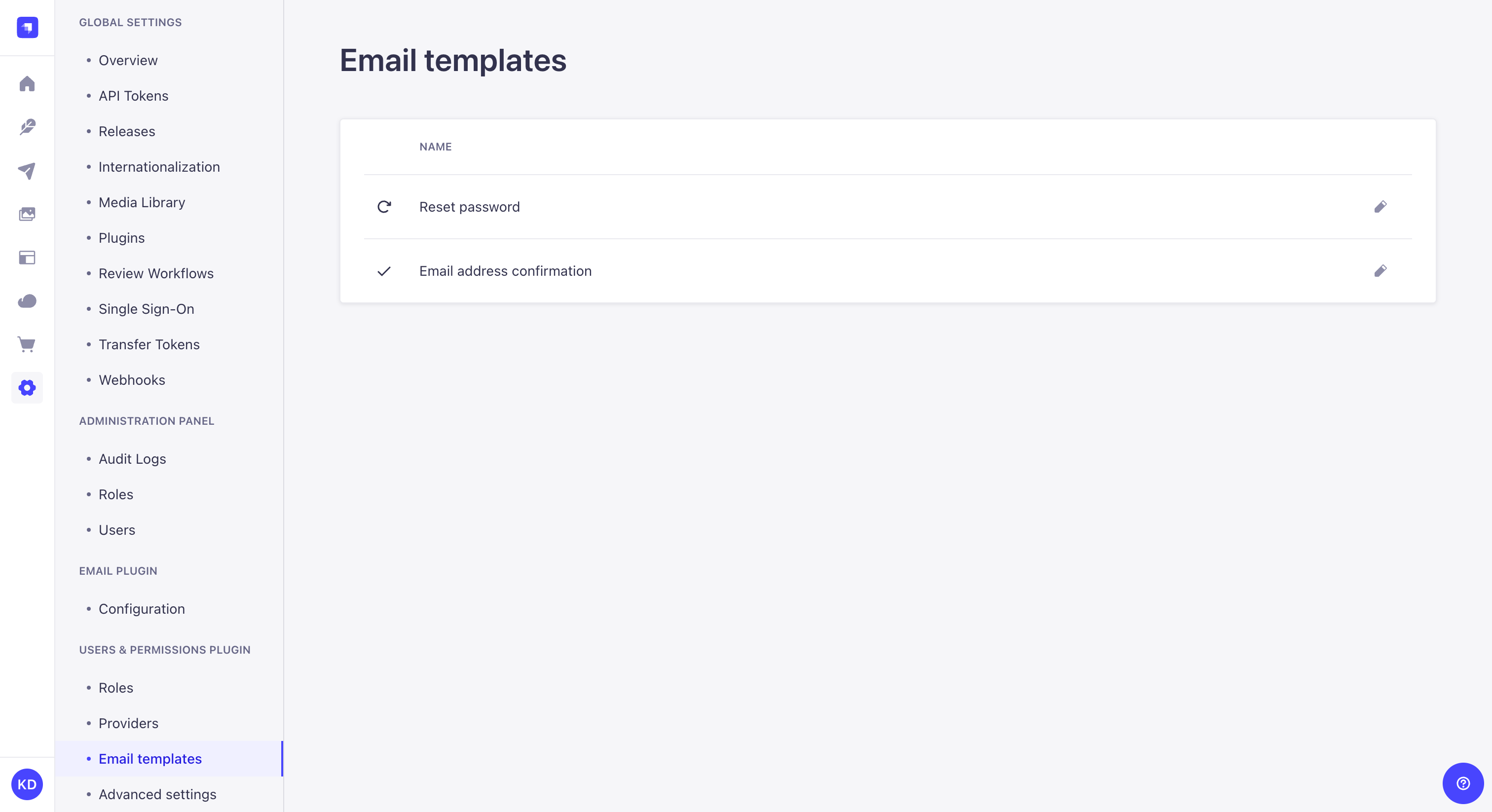
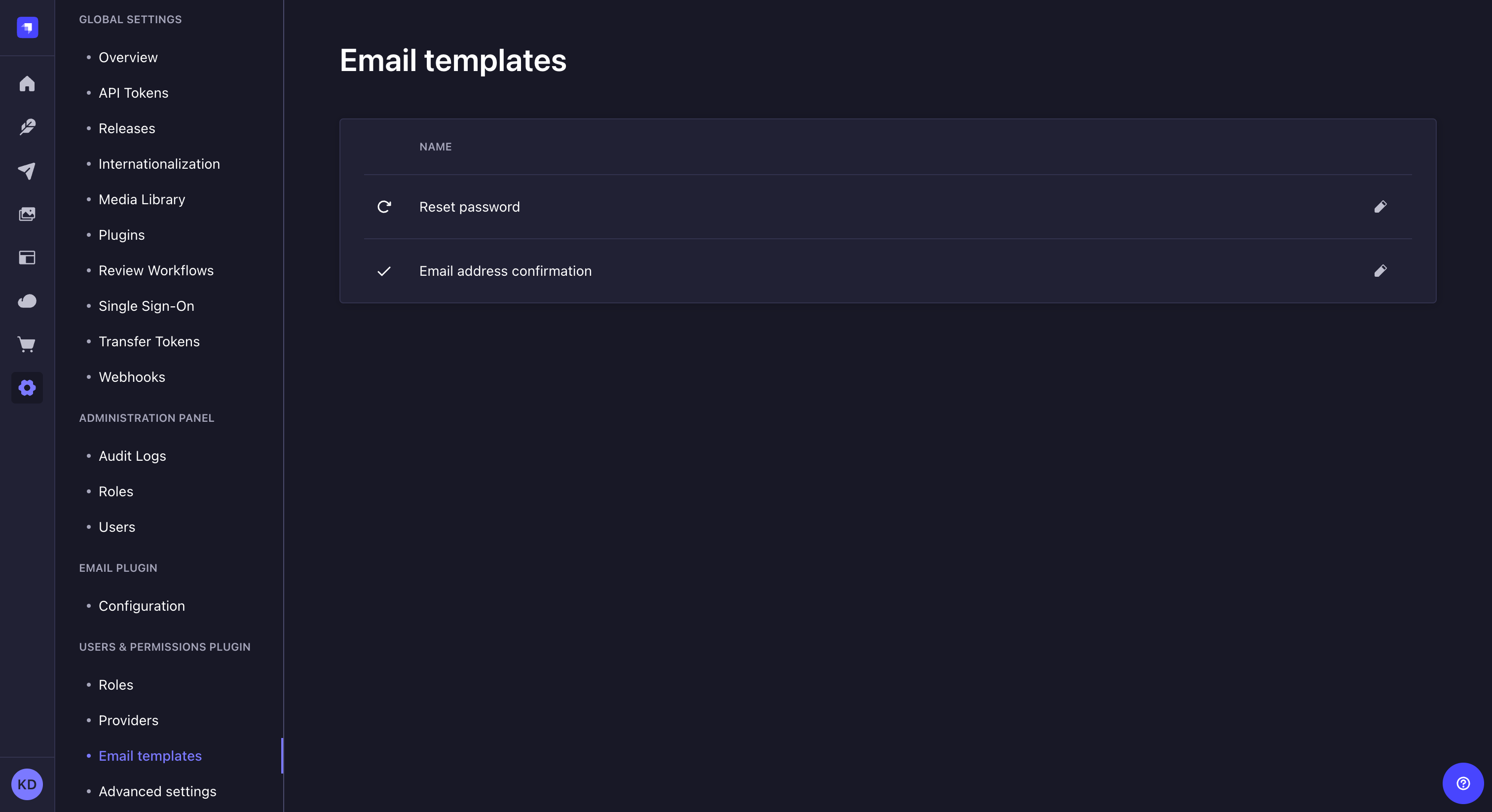
高级设置
¥Advanced Settings
路径: 用户和权限插件 > 高级设置
¥Path: Users & Permissions plugin > Advanced settings
与用户和权限功能相关的所有设置均通过高级设置界面进行管理,包括为终端用户选择默认角色、启用注册和电子邮件确认,以及选择用于重置密码的登录页面。
¥All settings related to the Users & Permissions feature are managed from the Advanced Settings interface, including the choice of a default role for end users, the enablement of sign-ups and email confirmation, as well as the choice of landing page for resetting a password.
-
按照以下说明配置你选择的设置:
¥Configure the settings of your choice, following the instructions below:
设置名称 指示 经过身份验证的用户的默认角色 单击下拉列表为新终端用户选择默认角色。 每个电子邮件地址一个账户 点击 TRUE 按钮可将具有相同电子邮件地址的终端用户账户数量限制为 1。
点击 FALSE 可禁用此限制,并允许多个终端用户账户与同一个电子邮件地址相关联(例如,当通过多个不同的提供商登录时,可以使用kai.doe@strapi.io)。启用注册 单击“TRUE”按钮以启用终端用户注册。
单击“FALSE”以阻止终端用户注册到你的前端应用。重置密码页面 指示前端应用的重置密码页面的 URL。 启用电子邮件确认 单击“TRUE”按钮,通过向终端用户发送确认电子邮件来启用账户确认。
单击“FALSE”以禁用账户确认。重定向网址 指示终端用户在确认其 Strapi 账户后应重定向到的页面 URL。 -
单击“保存”按钮。
¥Click the Save button.
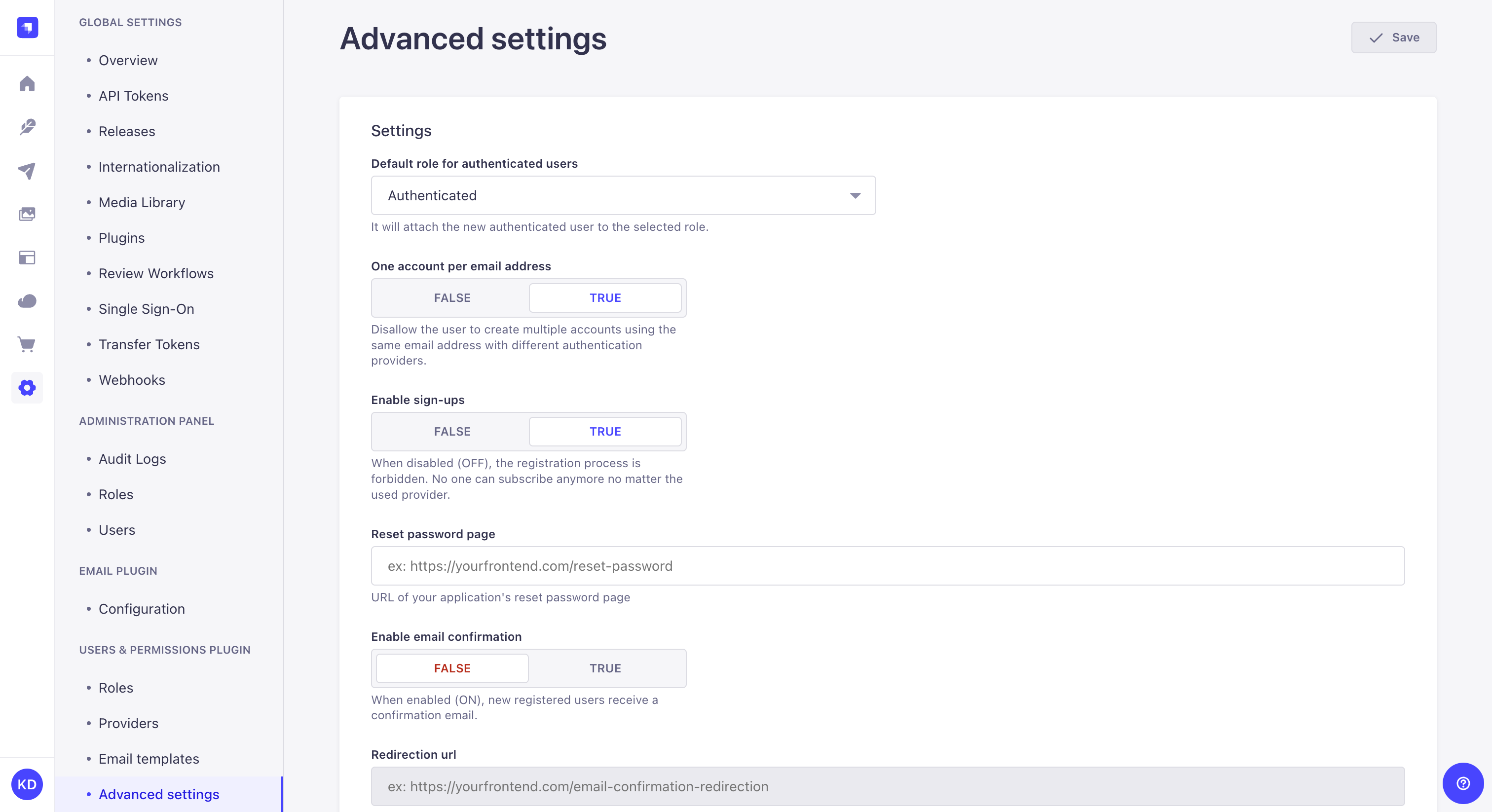
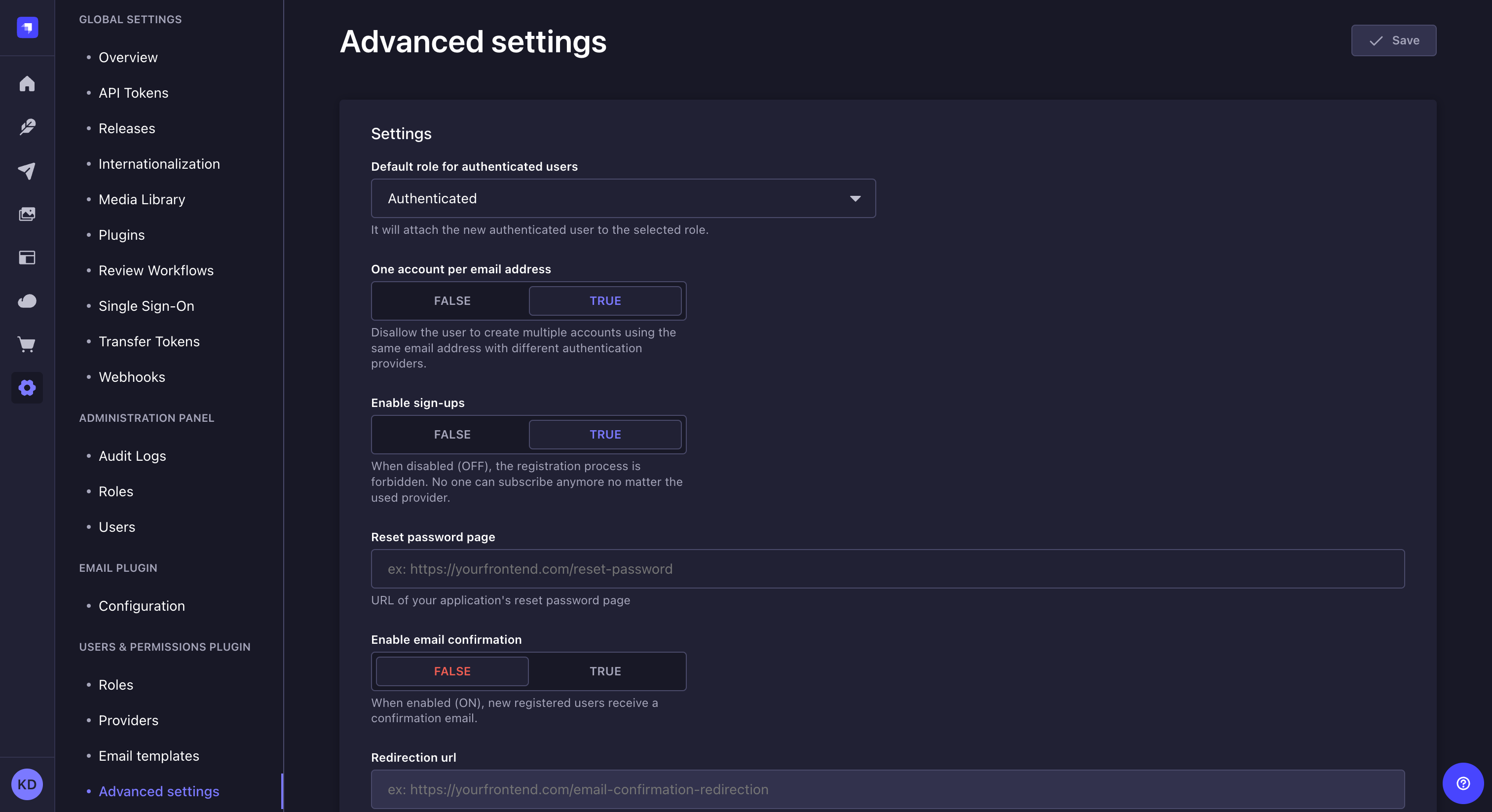
基于代码的配置
¥Code-based configuration
虽然大多数用户和权限设置都是通过管理面板处理的,但可以通过配置和自定义 Strapi 项目的代码来微调一些更具体的设置。
¥While most of the Users & Permissions settings are handled via the admin panel, some more specific settings can be fine-tuned by configuring and customizing your Strapi project's code.
JWT 配置
¥JWT configuration
你可以使用 插件配置文件 配置 JSON Web Token (JWT) 生成。
¥You can configure the JSON Web Token (JWT) generation by using the plugins configuration file.
Strapi 使用 jsonwebtoken 生成 JWT。
¥Strapi uses jsonwebtoken to generate the JWT.
JWT 管理模式
¥JWT management modes
用户和权限功能支持两种 JWT 管理模式。
¥The Users & Permissions feature supports 2 JWT management modes.
通过在 /config/plugins 文件 中设置 users-permissions.config 对象的 jwtManagement 属性来定义使用哪种模式。该属性接受 legacy-support 或 refresh:
¥Defining which mode is used is done by setting the jwtManagement property of the users-permissions.config object in the /config/plugins file. The property accepts either legacy-support or refresh:
| 模式 | 描述 | 使用案例 |
|---|---|---|
legacy-support | (默认)使用传统配置发出长寿命 JWT | 现有应用,简单身份验证 |
refresh | 使用会话管理,使用短期访问令牌和刷新令牌来增强安全性 | 新应用,增强的安全要求 (更多信息请参阅 管理面板配置 文档) |
为了向后兼容,“用户和权限”功能默认为旧模式:
¥For backwards compatibility, the Users & Permission feature defaults to legacy mode:
module.exports = ({ env }) => ({
'users-permissions': {
config: {
jwtManagement: 'legacy-support',
jwt: {
expiresIn: '7d', // Traditional JWT expiry
},
},
},
});
-
jwtSecret是用于创建新 JWT 的随机字符串,通常使用JWT_SECRET环境变量 设置。¥
jwtSecretis a random string used to create new JWTs, typically set using theJWT_SECRETenvironment variable. -
jwt.expiresIn(仅限旧版模式)以秒或描述时间跨度的字符串表示。
例如:60、"45m"、"10 小时"、"2 天"、"7 天"、"2 年"。数值被解释为秒数。如果你使用字符串,请确保提供时间单位(分钟、小时、天、年等),否则默认使用毫秒单位("120" 等于 "120ms")。¥
jwt.expiresInis (legacy-mode only) is expressed in seconds or a string describing a time span.
Eg: 60, "45m", "10h", "2 days", "7d", "2y". A numeric value is interpreted as a seconds count. If you use a string be sure you provide the time units (minutes, hours, days, years, etc), otherwise milliseconds unit is used by default ("120" is equal to "120ms").
出于安全考虑,不建议将 JWT 过期时间设置为超过 30 天。
¥Setting JWT expiry for more than 30 days is not recommended due to security concerns.
使用 refresh 模式时,配置文件可能如下所示:
¥When the refresh mode is used, the configuration file could look like as follows:
- JavaScript
- TypeScript
module.exports = ({ env }) => ({
// …
'users-permissions': {
config: {
jwtManagement: 'refresh',
sessions: {
accessTokenLifespan: 604800, // 1 week (default)
maxRefreshTokenLifespan: 2592000, // 30 days
idleRefreshTokenLifespan: 604800, // 7 days
httpOnly: false, // Set to true for HTTP-only cookies
cookie: {
name: 'strapi_up_refresh',
sameSite: 'lax',
path: '/',
secure: false, // true in production
},
},
},
},
// ...
});
export default ({ env }) => ({
// …
'users-permissions': {
config: {
jwtManagement: 'refresh',
sessions: {
accessTokenLifespan: 604800, // 1 week (default)
maxRefreshTokenLifespan: 2592000, // 30 days
idleRefreshTokenLifespan: 604800, // 7 days
httpOnly: false, // Set to true for HTTP-only cookies
cookie: {
name: 'strapi_up_refresh',
sameSite: 'lax',
path: '/',
secure: false, // true in production
},
},
},
},
// ...
});
注册配置
¥Registration configuration
如果你在用户模型中添加了任何其他字段
¥If you have added any additional fields in your User model
需要在注册时接受,你需要将它们添加到 /config/plugins 文件 的 config.register 对象中允许的字段列表中,否则将不被接受。
¥that need to be accepted on registration, you need to added them to the list of allowed fields in the config.register object of the /config/plugins file, otherwise they will not be accepted.
以下示例显示如何确保 API 在用户注册时接受名为 "nickname" 的字段:
¥The following example shows how to ensure a field called "nickname" is accepted by the API on user registration:
- JavaScript
- TypeScript
module.exports = ({ env }) => ({
// ...
"users-permissions": {
config: {
register: {
allowedFields: ["nickname"],
},
},
},
// ...
});
export default ({ env }) => ({
// ...
"users-permissions": {
config: {
register: {
allowedFields: ["nickname"],
},
},
},
// ...
});
速率限制配置
¥Rate limiting configuration
对身份验证和注册端点应用速率限制以防止滥用。可以配置以下参数来更改其行为。<ExternalLink text="koa2-ratelimit" to="[https://github.com/ysocorp/koa2-ratelimit?tab=readme-ov-file#configuration](https://github.com/ysocorp/koa2-ratelimit?tab=readme-ov-file#configuration)"/> 包提供了其他配置选项:
¥Rate limiting is applied to authentication and registration endpoints to prevent abuse. The following parameters can be configured to change its behavior. Additional configuration options are provided by the koa2-ratelimit package:
/config/plugins 文件 中提供了以下选项:
¥The following options are available in the /config/plugins file:
| 范围 | 描述 | 类型 | 默认 |
|---|---|---|---|
ratelimit | 用于自定义身份验证和注册端点速率限制的设置 | object | {} |
ratelimit.enabled | 启用或禁用速率限制器 | 布尔值 | true |
ratelimit.interval | 请求被视为同一速率限制桶一部分的时间窗口 | object | { min: 5 } |
ratelimit.max | 时间窗口内允许的最大请求数 | integer | 5 |
ratelimit.prefixKey | 速率限制键的前缀 | string | ${userIdentifier}:${requestPath}:${ctx.request.ip} |
- JavaScript
- TypeScript
module.exports = ({ env }) => ({
// ... other plugins configuration ...
// Users & Permissions configuration
'users-permissions': {
config: {
ratelimit: {
enabled: true,
interval: { min: 5 },
max: 5,
},
},
},
// ...
});
export default ({ env }) => ({
// ... other plugins configuration ...
// Users & Permissions configuration
'users-permissions': {
config: {
ratelimit: {
enabled: true,
interval: { min: 5 },
max: 5,
},
},
},
// ...
});
模板化电子邮件
¥Templating emails
默认情况下,该插件附带两个模板:重置密码和电子邮件地址确认。模板使用 Lodash 的 `template()` 方法 填充变量。
¥By default this plugin comes with two templates: reset password and email address confirmation. The templates use Lodash's `template()` method to populate the variables.
你可以在管理面板中的插件 > 角色和权限 > 电子邮件模板选项卡下更新这些模板(参见 配置电子邮件模板)。
¥You can update these templates under Plugins > Roles & Permissions > Email Templates tab in the admin panel (see configuring email templates).
可以使用以下变量:
¥The following variables can be used:
- Reset password
- Email address confirmation
USER(object)usernameemail
TOKENcorresponds to the token generated to be able to reset the password.URLis the link where the user will be redirected after clicking on it in the email.SERVER_URLis the absolute server url (configured in server configuration).
USER(object)usernameemail
CODEcorresponds to the CODE generated to be able confirm the user email.URLis the Strapi backend URL that confirms the code (by default/auth/email-confirmation).SERVER_URLis the absolute server url (configured in server configuration).
安全配置
¥Security configuration
JWT 可以被验证和信任,因为信息是经过数字签名的。要签署令牌,需要一个秘密。默认情况下,Strapi 生成并将其存储在 /extensions/users-permissions/config/jwt.js 中。
¥JWTs can be verified and trusted because the information is digitally signed. To sign a token a secret is required. By default Strapi generates and stores it in /extensions/users-permissions/config/jwt.js.
这在开发期间很有用,但出于安全原因,建议在部署到生产时通过环境变量 JWT_SECRET 设置自定义令牌。
¥This is useful during development but for security reasons it is recommended to set a custom token via an environment variable JWT_SECRET when deploying to production.
默认情况下,你可以设置 JWT_SECRET 环境变量,它将用作秘密。如果你想使用其他变量,你可以更新配置文件。
¥By default you can set a JWT_SECRET environment variable and it will be used as secret. If you want to use another variable you can update the configuration file.
- JavaScript
- TypeScript
module.exports = {
jwtSecret: process.env.SOME_ENV_VAR,
};
export default {
jwtSecret: process.env.SOME_ENV_VAR,
};
创建自定义回调验证器
¥Creating a custom callback validator
默认情况下,Strapi SSO 仅重定向到与配置中的 URL 完全相等的重定向 URL:
¥By default, Strapi SSO only redirects to the redirect URL that is exactly equal to the url in the configuration:
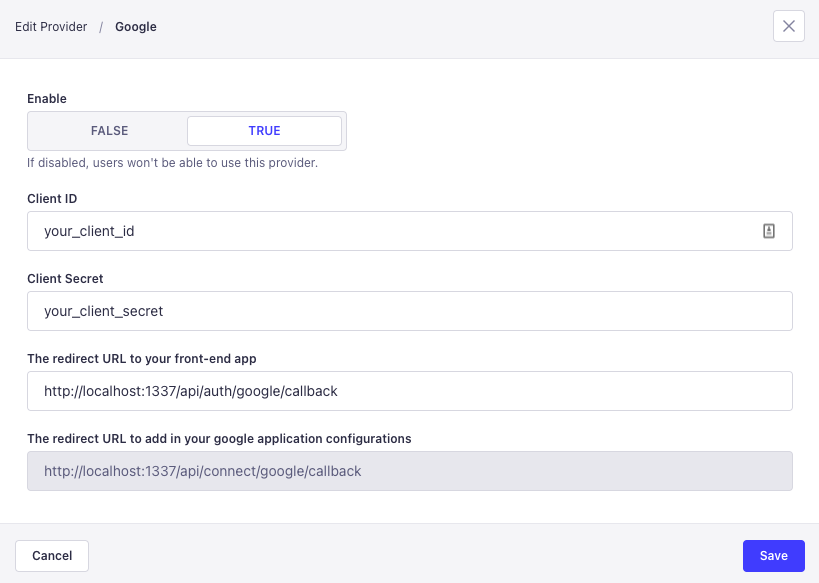
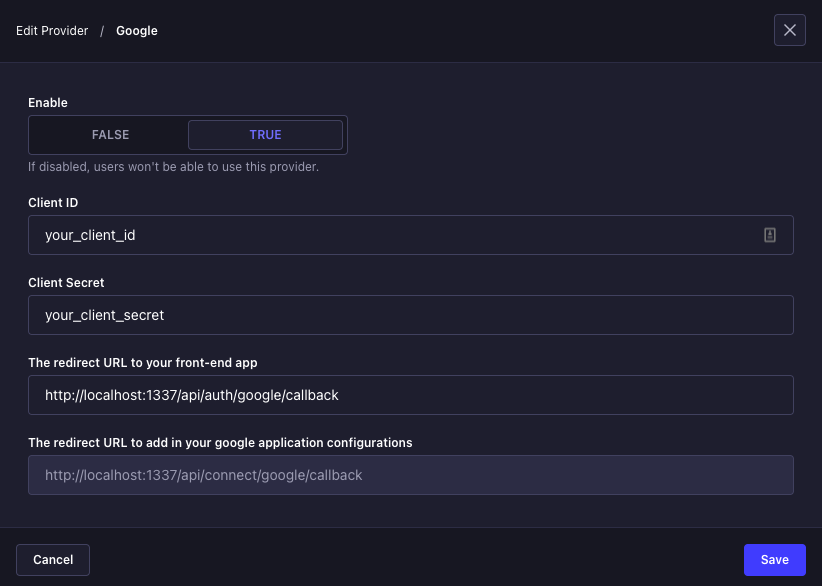
如果你需要配置自定义处理程序以接受其他 URL,则可以在 plugins.js 中为 users-permissions 插件创建回调 validate 函数。
¥If you need to configure a custom handler to accept other URLs, you can create a callback validate function in your plugins.js for the users-permissions plugin.
// ... other plugins configuration ...
// Users & Permissions configuration
'users-permissions': {
enabled: true,
config: {
callback: {
validate: (cbUrl, options) => {
// cbUrl is where Strapi is being asked to redirect the auth info
// that was received from the provider to
// in this case, we will only validate that the
// if using a base url, you should always include the trailing slash
// although in real-world usage you should also include the full paths
if (cbUrl.startsWith('https://myproxy.mysite.com/') ||
cbUrl.startsWith('https://mysite.com/')) {
return;
}
// Note that you MUST throw an error to fail validation
// return values are not checked
throw new Error('Invalid callback url');
},
},
},
},
用法
¥Usage
用户和权限功能既可以通过管理面板使用,也可以通过 API 使用,以创建新的终端用户账户。
¥The Users & Permissions feature can be used both via the admin panel, to create new end-user accounts, and via the APIs.
管理面板使用
¥Admin panel usage
使用功能的路径: 内容管理器
¥Path to use the feature: Content Manager
使用用户和权限功能,终端用户及其账户信息将作为内容类型进行管理。在 Strapi 应用上安装用户和权限时,会自动创建 3 种集合类型,包括 "用户",这是内容管理器中唯一可直接使用的类型。
¥With the Users & Permissions feature, the end users and their account information are managed as a content-type. When Users & Permissions is installed on a Strapi application, 3 collection types are automatically created, including "User" which is the only one available directly in the Content Manager.
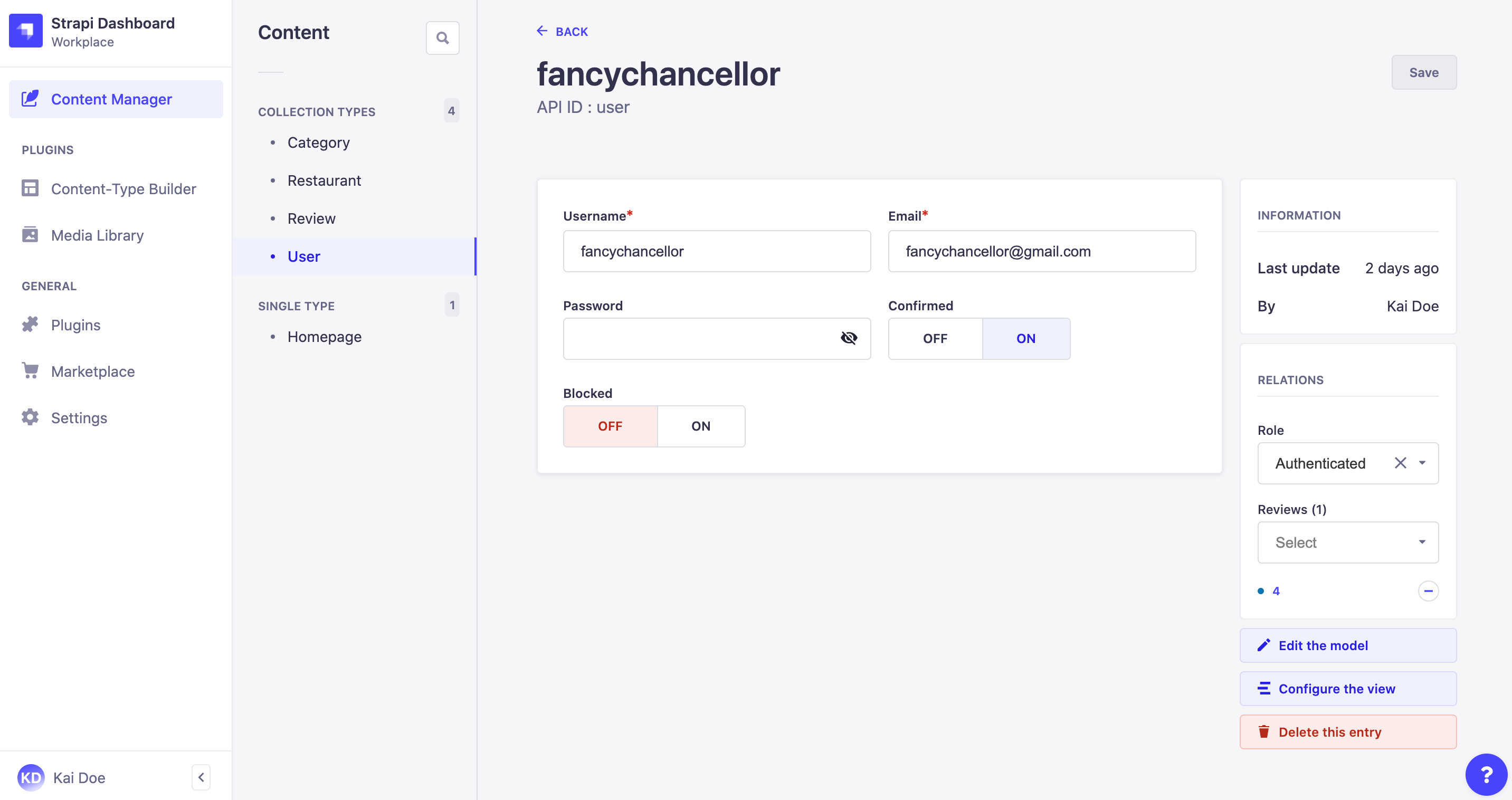
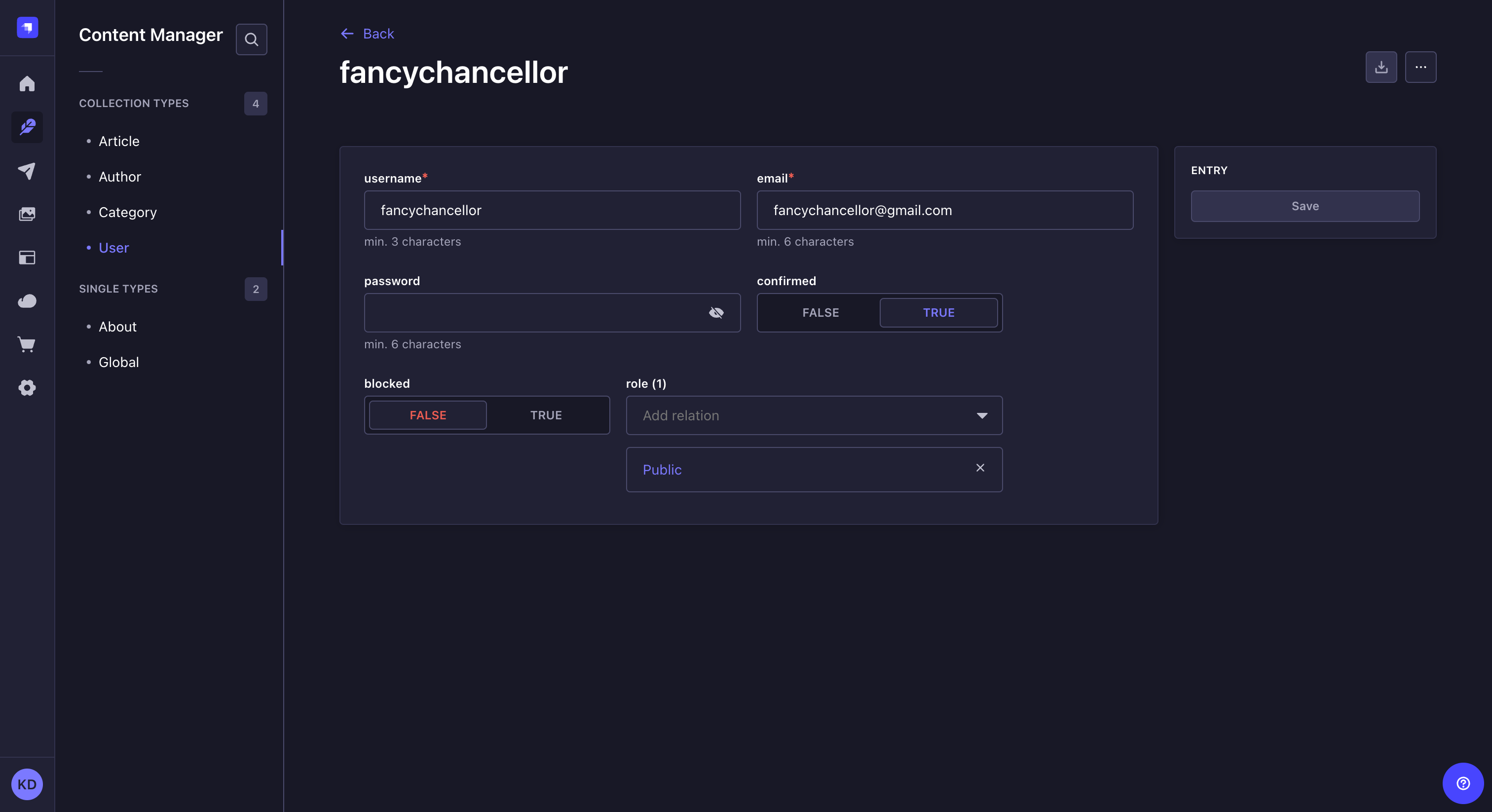
使用用户和权限插件在前端应用中注册新的终端用户包括向用户集合类型添加新条目。
¥Registering new end users in a front-end application with the Users & Permissions plugin consists in adding a new entry to the User collection type.
-
转到 内容管理器中的用户集合类型。
¥Go to the User collection type in the Content Manager.
-
单击右上角的“创建新条目”按钮。
¥Click on the Create new entry button in the top right corner.
-
填写条目的默认字段。管理员专门为你的 Strapi 应用添加的其他字段也可能会显示。
¥Fill in the default fields of the entry. Additional fields added specifically for your Strapi application by your administrators may be displayed as well.
字段 指示 用户名 写入终端用户的用户名。 电子邮件 在文本框中填写终端用户的完整电子邮件地址。 密码 (可选)在文本框中写入新密码。你可以单击 图标以显示密码。 已确认 (可选)单击“开”确认终端用户账户。 已阻止 (可选)单击“开”阻止终端用户的账户,以阻止他们访问内容。 角色 (可选)指示应授予新终端用户的角色。如果未填写此字段,则终端用户将被归为默认角色(请参阅 高级设置 中的 "默认角色" 选项)。 -
单击“保存”按钮。
¥Click on the Save button.
如果终端用户可以在你的前端应用上注册自己(请参阅 高级设置 中的 "启用注册" 选项),则会自动创建一个新条目,并且该条目的字段将填充终端用户指示的信息。不过,所有字段都可以由 Strapi 应用的管理员进行编辑。
¥If end users can register themselves on your front-end application (see "Enable signups" option in advanced settings), a new entry will automatically be created and the fields of that entry will be filled up with the information indicated by the end user. All fields can however be edited by an administrator of the Strapi application.
API 使用
¥API usage
每次发送 API 请求时,服务器都会检查 Authorization 标头是否存在,并验证发出请求的用户是否有权访问该资源。
¥Each time an API request is sent the server checks if an Authorization header is present and verifies if the user making the request has access to the resource.
当你创建没有角色的用户时,或者如果你使用 /api/auth/local/register 路由,则会向该用户授予 authenticated 角色。
¥When you create a user without a role, or if you use the /api/auth/local/register route, the authenticated role is given to the user.
基本身份验证端点
¥Basic authentication endpoints
用户和权限功能为用户管理和 内容 API 访问提供了以下身份验证端点:
¥The Users & Permissions feature provides the following authentication endpoints for user management and Content API access:
| 方法 | 网址 | 描述 |
|---|---|---|
POST | /api/auth/local | 用户使用邮箱/用户名和密码登录 (参见 identifier 参数) |
POST | /api/auth/local/register | 用户注册 |
POST | /api/auth/forgot-password | 请求密码重置 |
POST | /api/auth/reset-password | 使用令牌重置密码 |
GET | /api/auth/email-confirmation | 确认用户电子邮件地址 |
会话管理端点
¥Session management endpoints
启用 会话管理(jwtManagement: 'refresh')后,可以使用更多端点:
¥When session management is enabled (jwtManagement: 'refresh'), additional endpoints are available:
| 方法 | 网址 | 描述 |
|---|---|---|
POST | /api/auth/refresh | 使用刷新令牌刷新访问令牌 |
POST | /api/auth/logout | 撤销用户会话(支持特定设备注销) |
要刷新身份验证令牌,你可以发送以下请求:
¥To refresh your authentication token you could for instance send the following request:
curl -X POST http://localhost:1337/api/auth/refresh \
-H "Content-Type: application/json" \
-d '{
"refreshToken": "your-refresh-token"
}'
{
"jwt": "your-new-access-token"
}
要退出所有会话,请发送以下请求:
¥To log out of all sessions, send the following request:
curl -X POST http://localhost:1337/api/auth/logout \
-H "Authorization: Bearer your-access-token"
标识符
¥Identifier
请求中发送的 identifier ��参数可以是电子邮件或用户名,如下例所示:
¥The identifier parameter sent with requests can be an email or username, as in the following examples:
- Axios
- Postman
import axios from 'axios';
// Request API.
axios
.post('http://localhost:1337/api/auth/local', {
identifier: 'user@strapi.io',
password: 'strapiPassword',
})
.then(response => {
// Handle success.
console.log('Well done!');
console.log('User profile', response.data.user);
console.log('User token', response.data.jwt);
})
.catch(error => {
// Handle error.
console.log('An error occurred:', error.response);
});
如果你使用 Postman,请将正文设置为 raw 并选择 JSON 作为数据格式:
¥If you use Postman, set the body to raw and select JSON as your data format:
{
"identifier": "user@strapi.io",
"password": "strapiPassword"
}
如果请求成功,你将在 jwt 键中收到用户的 JWT:
¥If the request is successful you will receive the user's JWT in the jwt key:
旧模式响应:
¥Legacy mode response:
{
"jwt": "eyJhbGciOiJIUzI1NiIsInR5cCI6IkpXVCJ9.eyJpZCI6MSwiaWF0IjoxNTc2OTM4MTUwLCJleHAiOjE1Nzk1MzAxNTB9.UgsjjXkAZ-anD257BF7y1hbjuY3ogNceKfTAQtzDEsU",
"user": {
"id": 1,
"username": "user",
...
}
}
会话管理模式响应:
¥Session management mode response:
{
"jwt": "eyJhbGciOiJIUzI1NiIsInR5cCI6IkpXVCJ9...", // Short-lived access token
"refreshToken": "eyJhbGciOiJIUzI1NiIsInR5cCI6IkpXVCJ9...", // Long-lived refresh token
"user": {
"id": 1,
"username": "user",
...
}
}
令牌使用
¥Token usage
然后,jwt 可用于发出权限受限的 API 请求。要以用户身份发出 API 请求,请将 JWT 放入 GET 请求的 Authorization 标头中。
¥The jwt may then be used for making permission-restricted API requests. To make an API request as a user place the JWT into an Authorization header of the GET request.
默认情况下,任何没有令牌的请求都将采用 public 角色权限。在管理仪表板中修改每个用户角色的权限。
¥Any request without a token will assume the public role permissions by default. Modify the permissions of each user's role in the admin dashboard.
身份验证失败会返回 401 (unauthorized) 错误。
¥Authentication failures return a 401 (unauthorized) error.
token 变量是登录或注册时收到的 data.jwt。
¥The token variable is the data.jwt received when logging in or registering.
import axios from 'axios';
const token = 'YOUR_TOKEN_HERE';
// Request API.
axios
.get('http://localhost:1337/posts', {
headers: {
Authorization: `Bearer ${token}`,
},
})
.then(response => {
// Handle success.
console.log('Data: ', response.data);
})
.catch(error => {
// Handle error.
console.log('An error occurred:', error.response);
});
用户注册
¥User registration
可以像以下示例一样在数据库中创建一个默认角色为 'registered' 的新用户:
¥Creating a new user in the database with a default role as 'registered' can be done like in the following example:
import axios from 'axios';
// Request API.
// Add your own code here to customize or restrict how the public can register new users.
axios
.post('http://localhost:1337/api/auth/local/register', {
username: 'Strapi user',
email: 'user@strapi.io',
password: 'strapiPassword',
})
.then(response => {
// Handle success.
console.log('Well done!');
console.log('User profile', response.data.user);
console.log('User token', response.data.jwt);
})
.catch(error => {
// Handle error.
console.log('An error occurred:', error.response);
});
Strapi 上下文中的用户对象
¥User object in Strapi context
user 对象可用于成功验证的请求。
¥The user object is available to successfully authenticated requests.
经过身份验证的 user 对象是 ctx.state 的属性。
¥The authenticated user object is a property of ctx.state.
create: async ctx => {
const { id } = ctx.state.user;
const depositObj = {
...ctx.request.body,
depositor: id,
};
const data = await strapi.services.deposit.add(depositObj);
// Send 201 `created`
ctx.created(data);
};